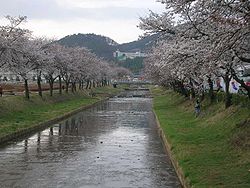| Jeomchon | |
 Mojeoncheon stream in Jeomchon. | |
| Korean name | |
|---|---|
| Hangul | 점촌 |
| Hanja | |
| Revised Romanization | Jeomchon |
| McCune–Reischauer | Chŏmch'on |
Jeomchon is the urbanized center of Mungyeong city,in Gyeongsangbuk-do province,South Korea. The name literally means "mountain-pass village",and may refer to the low hills that run along the edge of town. It has a population of about 45,000 (based on 2003 city residence figures [ permanent dead link ]),on an area of roughly 45 km2. Jeomchon comprises roughly the five dongs known today as Jeomchon 1-dong through Jeomchon 5-dong.
Jeomchon contains the seat of Mungyeong city government,and the city's principal bus and train stations. It is home to more than half of the city's population,although it takes up only 5% of the city's land,and thus also serves as a major economic center for Mungyeong.
From 1986 to 1995,Jeomchon was a separately-administered city. Its merger with Mungyeong County in 1995 created the present-day entity of Mungyeong-si.